|
|
 53 mastodont DHJanzen101186.jpg high resolution
|
|
|
More recently than the coal beds, it is clear that Alaska as recently as the end of the Pleistocene had a rich megafauna -herbivores and their carnivores - most of which went down in the same period as did the megafauna of the lower 48 and the neotropics. While there are those who are fond of wanting this cross-species large mammal extinction to be due to anything but humans (disease and climate change are the favorite candidates), as far as I am concerned, humans are the only serious contenders (with a bit of help from the starving carnivores who would have cleaned up the last remnants). Climate change can be easily disposed of by simply asking what kind of climate change would it take to knock any of the large extant generalist mammals off the face of Africa or tropical Asia - there is none other than total desertification or glaciation, neither of which happened 11,500 years ago. Disease would have had to be cross-taxon capable, and there simply are no candidates and such a natural history simply does not make sense. This is a 11,000-year-old Alaskan mastodont molar from the Fairbanks area - the high crowns on the molar sections are those of a twig-eater/browser. This animal would have had a great time with poplar and birch branches, and willow shrubbery (and perhaps even some of the low ericaceous shrubbery that is too toxic to be browsed by extant mammals). On the other hand, such an animal would have greatly changed the monotony of the untouched stands in image DHJanzen101147.jpg above. How did such an animal - and the mammoths below - survive the Pleistocene glaciations prior to their Pleistocene extinction by people? Crazy as it sounds, apparently owing to wind and moisture patterns, despite the cold, large parts of Alaska were not glaciated during the times when the major ice sheets pushed south through central North America. |
||
back to lecture slides
or skip to: